A growth and income fund represents a type of diversified investment fund that seeks to balance the dual objectives of capital appreciation (growth) and current income. This class of funds typically invests in a mix of equities that show potential for price increases and fixed-income securities that yield regular income, such as bonds or dividend-paying stocks. Growth and income funds aim to offer investors the best of both worlds. By combining growth stocks and income-generating assets, these funds offer a balanced investment approach. They provide an opportunity for capital appreciation while also generating a steady income stream, making them a desirable option for investors seeking moderate risk levels. Growth investments are typically represented by equities in companies that are expected to grow at an above-average rate compared to other companies in the market. These companies often reinvest their earnings into further expansion, technological advancements, or acquisitions rather than paying out dividends. The primary goal is to realize a high return on investment (ROI) through the increase in the stock's price over time. Income investments, on the other hand, focus on securities that generate a steady income stream. This category typically includes bonds and dividend-paying stocks. Bonds generate income through interest payments, while dividend stocks distribute a portion of the company's profits to its shareholders. These investments are considered less risky than growth investments, providing stability to the portfolio. Growth and income funds strike a balance between risk and reward by including both growth and income assets. While growth stocks have the potential for high returns, they come with increased volatility and risk. Income investments, while generating a steady income, usually offer slower growth. A well-managed growth and income fund can provide investors with a stable income stream and the potential for capital appreciation while also mitigating the risks associated with each type of asset. The asset allocation in a growth and income fund is crucial to achieving its dual objectives. Fund managers strategically divide the fund's assets between growth and income investments. The exact allocation can vary significantly from one fund to another, depending on the fund's investment strategy, risk tolerance, and the economic environment. Diversification is another key feature of growth and income funds. By spreading investments across various sectors, geographical areas, and asset types, these funds aim to mitigate risks and smooth out returns. This broad exposure can help protect the portfolio against market volatility and potential losses from any single investment. Growth and income funds can be either actively or passively managed. Actively managed funds involve fund managers making decisions about how to allocate assets based on market research and forecasts. Conversely, passively managed funds, often structured as index funds or ETFs, aim to mirror the performance of a specific benchmark or index. Domestic growth and income funds primarily invest in securities from a specific home country. For instance, a U.S. domestic growth and income fund might invest in American growth stocks and U.S. Treasury bonds. These funds offer a way for investors to participate in the growth of their home country's economy while also enjoying income from more stable, income-producing securities. International growth and income funds invest in securities from various countries around the world. This type of fund provides investors with exposure to global markets, offering broader diversification and the potential to capitalize on growth in emerging and developed economies. However, they also come with additional risks, such as currency risk and geopolitical risk, which can impact the fund's performance. Sector-specific growth and income funds focus on specific industries or sectors, such as technology, healthcare, or utilities. These funds allow investors to benefit from the growth and income generated within a particular sector. However, they may carry a higher risk due to their lack of diversification across different sectors. Growth and income funds can be structured as either exchange-traded funds (ETFs) or mutual funds. ETFs are traded on the stock exchange and can be bought or sold throughout the trading day at market prices. Mutual funds, on the other hand, are bought or sold at the end of the trading day at a price known as the net asset value (NAV). Both types offer diversification and can cater to growth and income strategy, but they differ in their management styles, fees, and investment minimums. Investors should examine a fund's historical performance to understand how it has been managed in different market conditions. While past performance isn't a guarantee of future results, it can provide insights into the fund's potential for growth and income. The dividend yield can be an important factor for those looking for income. It's the annual dividend income per share divided by the market price per share. A higher yield may indicate a better income-generating investment. The expense ratio is the annual fee that all funds charge their shareholders. It's important to consider because even small differences can significantly impact long-term returns. Consider the fund manager's experience, investment philosophy, and strategy. Look for managers with a successful track record in managing growth and income funds. Understand the risks involved with the fund. This includes market risk, sector-specific risks, interest rate risk, and the risk associated with international investing. Growth and income funds can provide a balance between risk and return, offering both capital appreciation and income generation. This balance can create a more stable portfolio that can weather different market conditions. For those looking for a consistent income stream, particularly retirees, growth and income funds can be an excellent option. The income portion of these funds can provide steady, predictable income. While income is a focus, these funds also aim for capital appreciation to help investors' portfolios keep pace with inflation and increase wealth over time. These funds offer a balanced investment strategy that combines the potential for capital appreciation with the stability of income generation. This can be particularly beneficial for investors looking for a moderate risk profile. Growth and income funds typically invest in a mix of asset types, sectors, and sometimes geographical regions, which can help spread risk and potentially enhance returns. These funds can provide a steady stream of income, typically through dividends or interest payments. This can be particularly attractive to retirees or others who need regular income from their investments. While these funds focus on income generation, they also aim for capital appreciation, which can help investors grow their wealth over the long term. Growth and income funds are usually managed by professional fund managers who make strategic decisions about asset allocation based on extensive research and market analysis. These funds are accessible to most investors, often with relatively low minimum investment requirements. They can be an easy way for individuals to gain exposure to a diversified portfolio of growth and income-generating assets. Like all investments, growth and income funds are subject to market risk. Changes in the economic landscape can negatively impact the value of the assets within the fund. While growth and income funds offer a balanced approach, they may not offer the same potential for high returns as pure growth funds due to their focus on income-producing assets, which typically have lower growth potential. Growth and income funds, particularly those that are actively managed, can carry higher fees than other types of funds, which can eat into returns. It's essential to understand all costs associated with a fund before investing. A growth and income fund aims to provide capital appreciation and regular income by investing in high-growth equities and fixed-income securities. It offers a balanced approach through strategic asset allocation and diversification. Consider factors like historical returns, dividend yield, and expense ratio when selecting a fund. Assess the fund manager's experience, investment strategy, and associated risks. Growth and income funds provide a balance between growth, stability, income generation, and capital appreciation. However, they come with market risks, limited potential returns compared to pure growth funds, and management fees. Seek professional advice, such as wealth management services, to tailor your investment strategy to your financial goals and risk tolerance. A trusted financial advisor can help you make informed decisions.What Is a Growth and Income Fund?
Concept of Growth and Income Funds
Balanced Approach
Growth Investments
Income Investments
Risk and Reward Balance
Structure of a Growth and Income Fund
Asset Allocation
Diversification
Management Styles: Active vs Passive
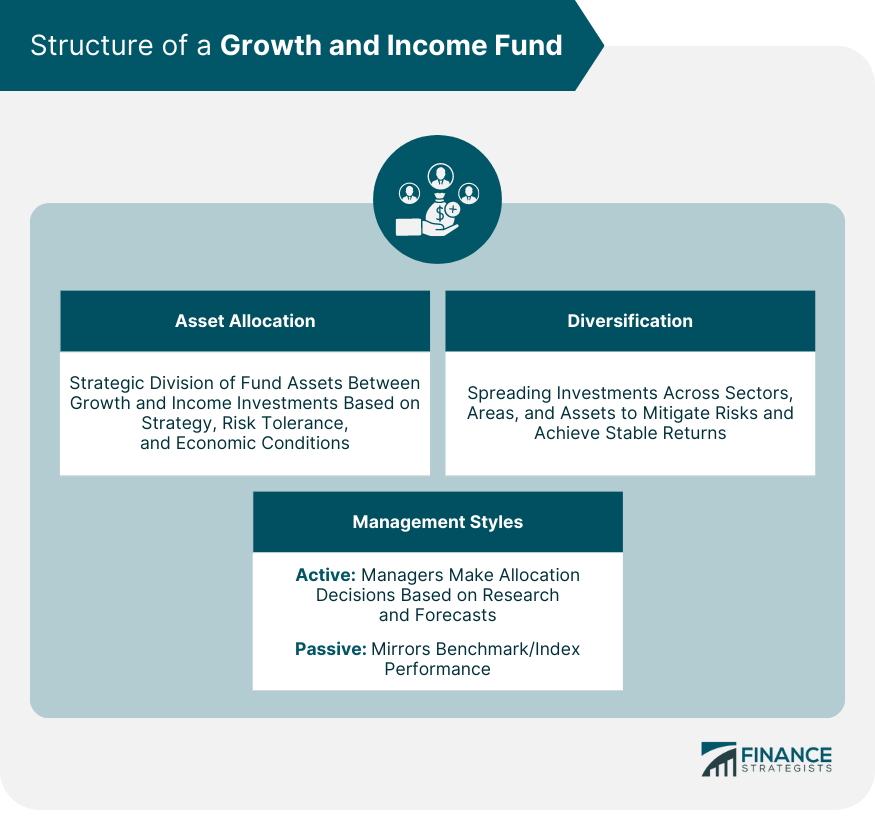
Types of Growth and Income Funds
Domestic Growth and Income Funds
International Growth and Income Funds
Sector-Specific Growth and Income Funds
ETFs and Mutual Funds
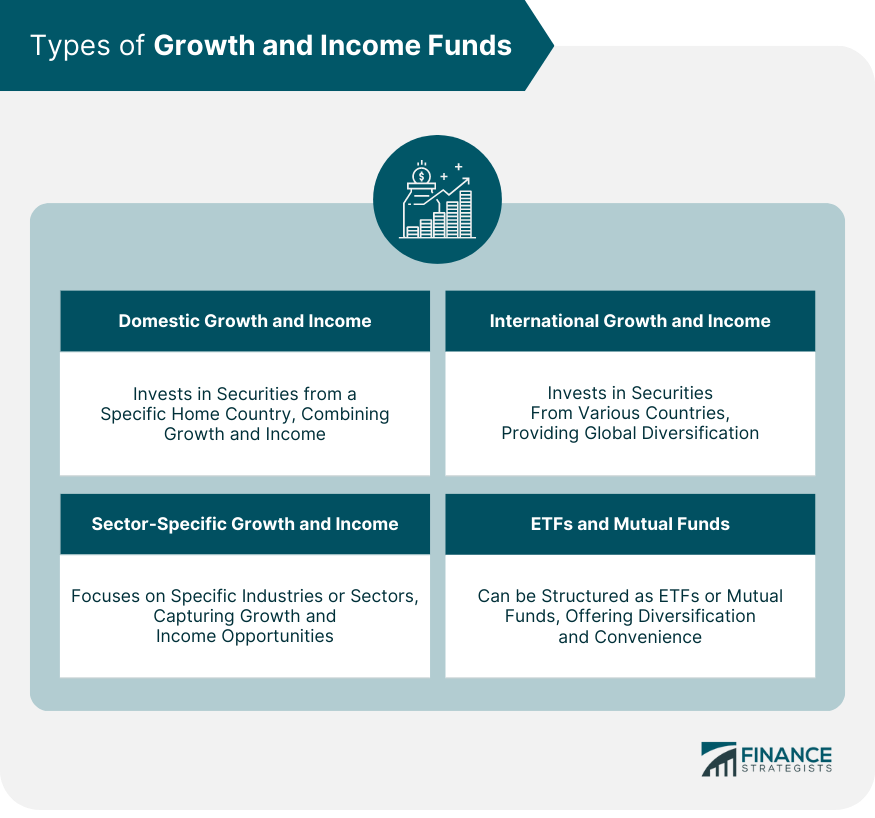
Evaluation and Selection of Growth and Income Funds
Performance Metrics
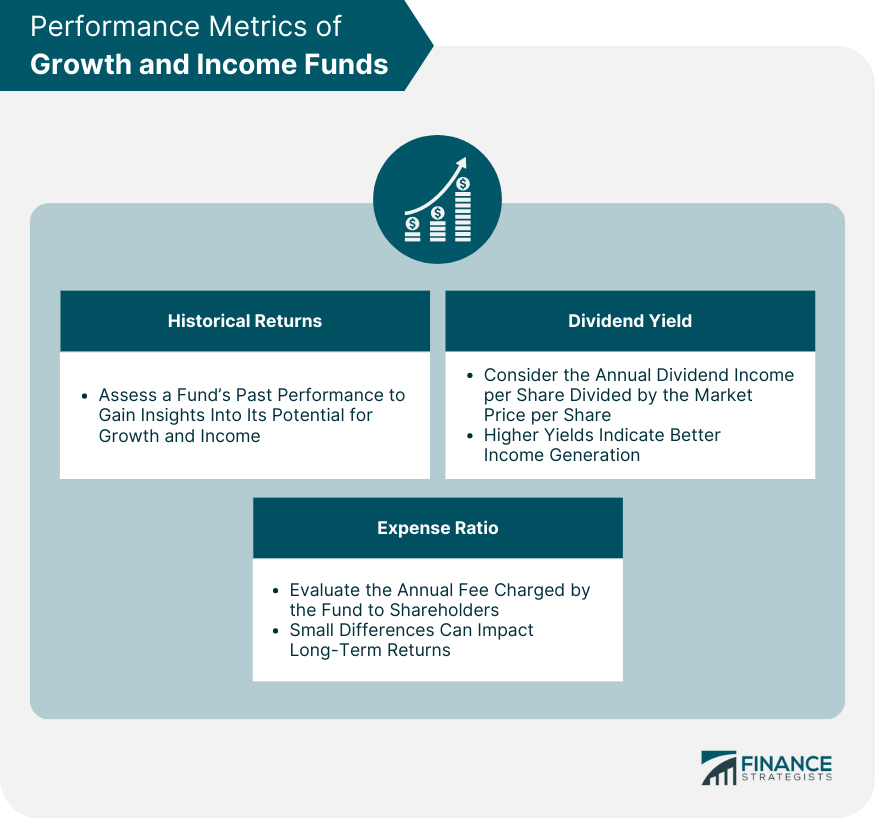
Historical Returns
Dividend Yield
Expense Ratio
Fund Manager and Investment Strategy
Risk Considerations
Role of Growth and Income Funds in Portfolio Management
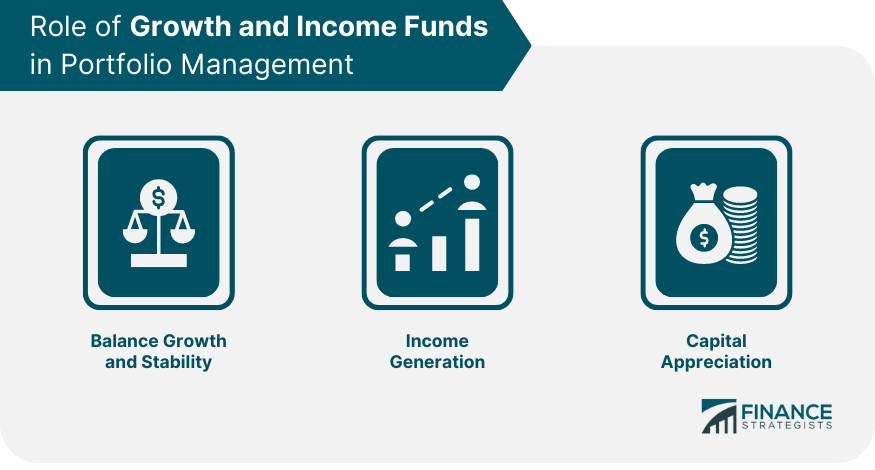
Balancing Growth and Stability
Income Generation
Capital Appreciation
Benefits of Growth and Income Funds
Balanced Approach
Diversification
Income Generation
Potential for Capital Appreciation
Professional Management
Accessibility
Potential Drawbacks of Growth and Income Funds
Market Risks
Limited Potential Returns Compared to Pure Growth Funds
Management Fees
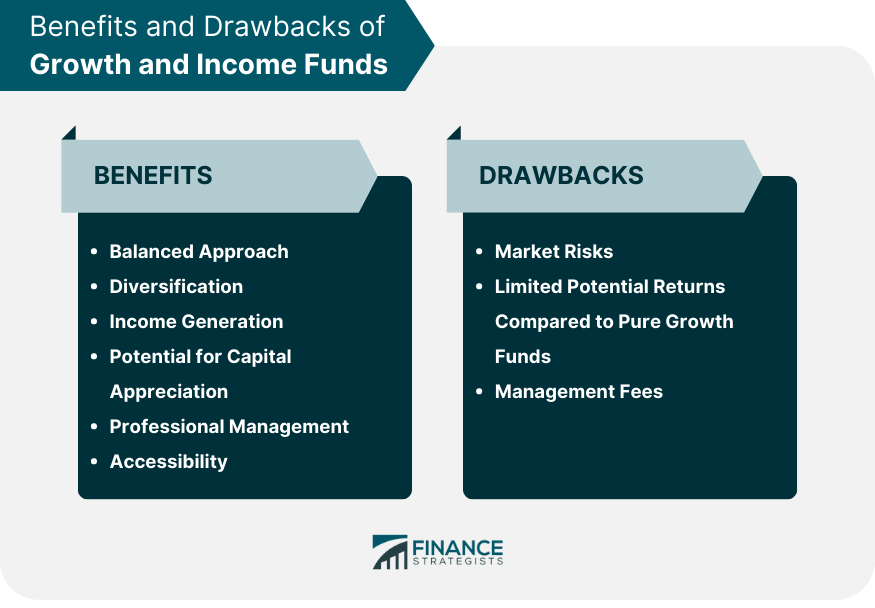
Final Thoughts
Growth and Income Fund FAQs
Growth and income funds are a type of investment fund that aims to provide both capital appreciation (growth) and regular income. These funds typically invest in a combination of growth stocks, which have the potential for price increase, and income-generating securities like bonds or dividend-paying stocks.
Growth and income funds work by balancing investments between growth and income-generating assets. The fund managers strategically allocate the fund's assets to achieve a mix that aligns with the fund's objectives and risk tolerance. They seek growth through equities expected to increase in value and generate income through fixed-income securities or dividend-paying stocks.
Growth and income funds are suitable for investors looking for a balanced investment approach. They can be particularly attractive to those seeking regular income, like retirees, as well as those looking for potential capital appreciation to grow their wealth over time. However, as with any investment, individual financial goals, risk tolerance, and investment timeline should be considered.
Investing in growth and income funds involves risks such as market risk, where the overall market decline affects the fund's value. Other risks include sector-specific risks if the fund invests heavily in one sector, interest rate risks for the income-generating portion of the fund, and management risk, where the fund manager's investment decisions might not achieve the desired result.
Selecting the best growth and income fund involves evaluating the fund's historical performance, dividend yield, expense ratio, and the fund manager's experience and strategy. It's also important to assess your risk tolerance and investment goals. Consulting with a financial advisor can be beneficial in making an informed decision.
True Tamplin is a published author, public speaker, CEO of UpDigital, and founder of Finance Strategists.
True is a Certified Educator in Personal Finance (CEPF®), author of The Handy Financial Ratios Guide, a member of the Society for Advancing Business Editing and Writing, contributes to his financial education site, Finance Strategists, and has spoken to various financial communities such as the CFA Institute, as well as university students like his Alma mater, Biola University, where he received a bachelor of science in business and data analytics.
To learn more about True, visit his personal website or view his author profiles on Amazon, Nasdaq and Forbes.











